AUCTORES
Globalize your Research
Research Article | DOI: https://doi.org/10.31579/2639-4162/219
1 Physical Therapist NDT teacher IBITA, Course Leader and teacher on the Dutch Institute for Allied Health Sciences. Nursing Home “Waelwick” in Ewijk the Netherlands.
2 MSc BSc RMN Lecturer in Mental Health Nursing with Dementia Specialty. University of Cumbria, Bowerham Road, Lancaster, LA1 3JD England.
*Corresponding Author: Jan van de Rakt, Physical Therapist NDT teacher IBITA, Course Leader and teacher on the Dutch Institute for Allied Health Sciences. Nursing Home “Waelwick” in Ewijk the Netherlands.
Citation: Jan Van de Rakt, Steve McCarthy-Grunwald, (2024), Treatment of the severe rigidity in the morning by Parkinson, J. General Medicine and Clinical Practice, 7(16); DOI:10.31579/2639-4162/219
Copyright: © 2024, Jan van de Rakt. This is an open-access article distributed under the terms of the Creative Commons Attribution License, which permits unrestricted use, distribution, and reproduction in any medium, provided the original author and source are credited.
Received: 23 August 2024 | Accepted: 05 September 2024 | Published: 13 September 2024
Keywords: rigidity; Parkinson; last phase of parkinson disease; tone treatment through push-away orthosis
Background/ Aim.
Treatment of people with Parkinson will be continued through the whole life of this person. All away until the last phase often in a Nursing home and often is he/she dependent of an wheelchair /bed. The part of the disease in the beginning is well documented and the number of treatments are enormous and of an great high degree, but this degenerative disease will change the possibilities dramatic and then is treatment an lot more difficult and thus also the results are often minimal. This phase asked for our attention, intervention and measurements to develop a treatment with an evident base.
Design.
The approach done by people with dementia that are in the Foetal attitude was the start that our attention also goes to people with Parkinson in the last phase. Because the amount of stiffness was so height that the resemblance was great with paratonia. Paratonia is an pathological neurological tone increase that can lead to an attitude that is hardly to change and people where often cognitive total absent. Elements of this “picture’ say we also by people with the last phase of Parkinson and often in morning and measurements of the tone give us the clarity that also there was an high pathological neurological tone.
Result.
The intervention though pressure on the feet by hard pillows and/or orthosis gave an reaction of “pushing away” and that is an movement. Movements does not possible when the tone was so high especially in the morning. Then this tone was around Mas-P = 4 but through this “stimulation” movements, this tone decreases almost 2 levels to Mas-P= 2. This tone decrease makes the whole morning ADL with the transfers and eating better possible and give the quality of live an positive kick.
Discussion and conclusion
The treatment possibilities for people at the end of the disease of Parkinson are limited but there are possibilities. This article about the reaction of hard pillows and/or orthosis with the investigation of the reaction though tone measurements should be an start for further good research how we can hold the quality of life as high as possible.
Parkinson ‘disease is a degenerative disease that is increasing in the world through all kinds of reason but also through pesticides [1] and that asked for ban on it, but also for a network to treat and go along with this people the whole way of this disease. In the Netherlands is the Parkinson Net start with this network that is also going international [2,3,4]. The result is that more understanding is now for this disease and that people will be see earlier and therefore will a longer and especially an higher quality of life, be possible. But still, it is a neurological disease that will go over many years but the symptoms will be bigger and that asked for treatment that has an answer for everyone to make live as well as possible.
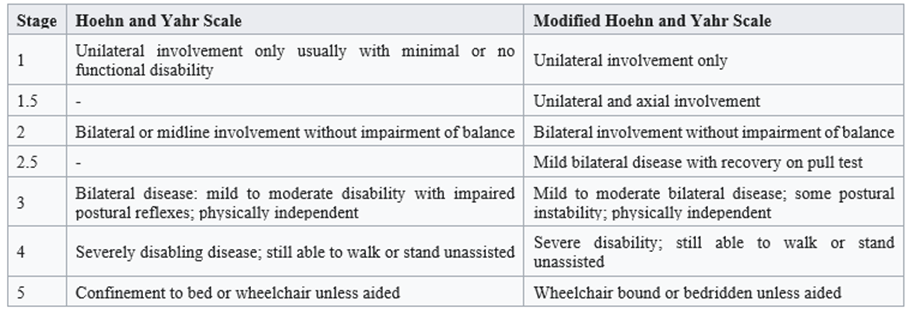
Table 1 [5]
The development of this disease is evident and it also obvious that at the end this people are dependent of assistance in all domains of movement and ADL. Further, the possibilities to speak, eat and swallowing at the end always a problem that need extra attention. Treatment with medications will help for a long period and also but regrettable lesser at the end and then is it important that the caregivers around the person has possibilities to increase the quality of live. So will the Pisa attitude have an influence on the swallowing capacity of this person and can this be decrease for moments through the day so that eating, swallowing get better. [7,8]
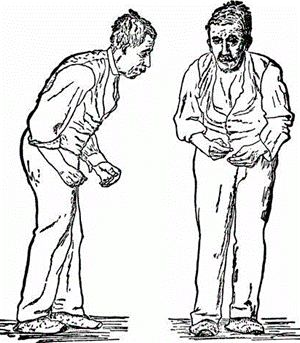
Picture 1: The picture that for long time has THE association with the Parkinson disease. This isn’t the picture that many people have, thanks to the increase of the treatment but regrettable will the attitude, the symptoms as stiffness, freezing, balance loss etc. be so clear that for all is assistance needed to get out the bed, in the clothes etc. In all books in literature this stiffness is a great problem and therefore must we search, what the cause of this stiffness is and or we can change/decrease it for moments through the day as by the Pisa syndrome.
In many literatures this stiffness is described as follow;
Stage 5 [6] “This is the most advanced and debilitating stage. Stiffness in the legs make it impossible to stand and walk. The person is bedridden or confined to a wheelchair unless aided. Around the-clock care is required for all activities.
Rigidity
This stiffness has a direct association with the tone in the muscles-pattern and with the neural possibilities that the damaged brain has.
Quote [10]; Objective rigidity' in PD correlates with velocity-dependent abnormal neuronal activity. The observations overall (i.e. the velocity-dependent feature of biomechanical and neurophysiological measures of objective rigidity) would point to a putative subcortical network responsible for 'objective rigidity' in PD, which requires further investigation.[9]
Quote [11]: People with PD exhibit higher values in terms of objective muscle stiffness than healthy controls. Rigidity depends on the angular velocity and articular amplitude of the mobilization applied. There are objective, valid, and reliable methods that can be used to quantitatively assess rigidity in people with PD. [10,11]
This higher tone and loss of selectivity, dexterity is the adaptation that the damaged brain must do, to get, with his lowering possibilities, the optimal control over “mind” and body and that will at the end give this enormous stiffness – rigidity but when we help the brain with information than is it possible, on moments through the day create less rigidity and possibility to move etc. Cools [13,14] et al. use the circles according Fowles to make clear what the alternatives are when a system in the brain lost their function. This has led to treatment with all kinds of cues [12] etc. and give us possibilities so seek for alternative route to decrease the rigidity for certain moments. This element that the treatment will never have a great affect through the whole day, has to do with the capacity of the damaged brain and his capacity to react on information and also on the level of this information -input- because not all input and certainly in stage 5 will enter the brain and has the same effect.
According to Cools et al. must this a stimulus on extero- /proprioceptive level and dynamic. This dynamic is so important because than will the extinction [15] be low but it has also an aspect that this group of people has a low cardio/pulmonal system, thus are they not capable to react long on this dynamic extero-/proprioceptive stimuli.
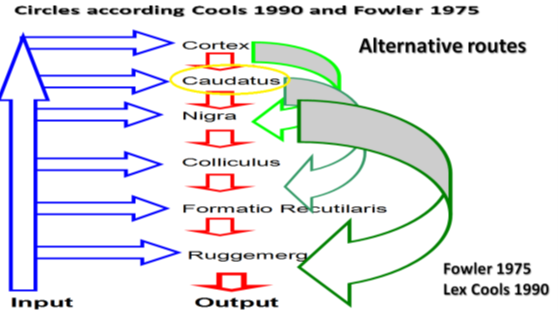
Figure 1: This figure gives a picture what the damaged brain does to decrease the effect of an bad functioning of the area around the caudates by searching for other ways. See the upper circle through the cortex, this cost more time but the control on tone, selectivity is than still possible. But when the disease progressed is this circle not possible anymore and are there only circles on a lower level possible and that has as consequences.
The consequences when the brain must use lower levels is;
Scientific evidence.
Scientific evidence is collected in the work of “The New Cognitive Neurosciences “under chief editor Cazzaniga [21c], the present of the projection in the brain and the greatness of it, determinate selectivity, dexterity, differentiation and height of tone. Damage og the somatosensory cortex forced the damaged brain to use lower situated projections, with restricted possibilities.
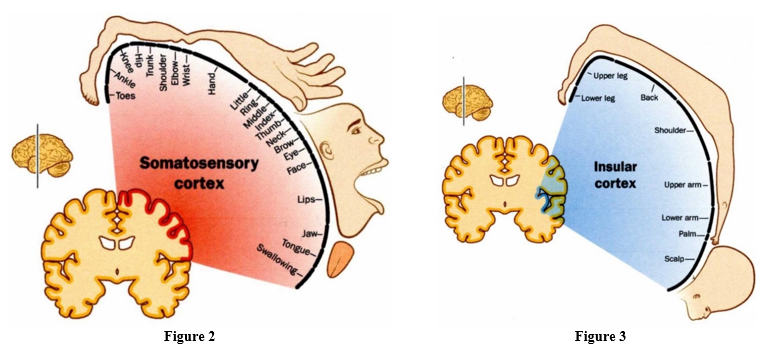
Figure 2 and 3: The projections on the somatosensory cortex figure 2 let us see much room for selectivity and thus movements variations but when we these projections see on the insular cortex than is that room almost gone and lies the focus on the base of the trunk and will the system must use, a system with limited movements possibilities. This will be achieved through the use of pathological synergies with a high tone and the highest tone will be used to create no movements at all.
This adaptation will create another way of moving and/or holding an attitude, thus must we search for another intervention.
This will give the follow picture!
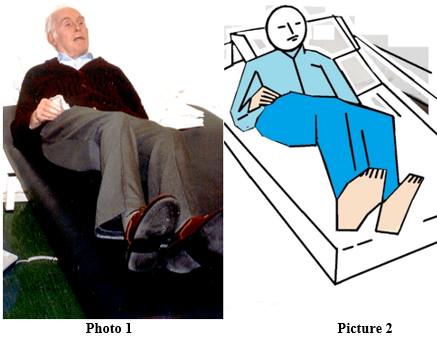
Photo 1 and Picture 2: The photo and the picture are the same person but through the picture is the attitude of the arms and legs clearer and see we the dominancy of the back diagonals and thus the dominancy of the flexion synergy (arms) and extension synergy (legs). Always lies by many people the focus on the feet and hand but by degenerative neurological disease will often early in the developmental of the disease the greatest tone increases and the necessary to use the synergy, lies in the trunk and the great joint as shoulder and hip and that because they are necessary to hold the balance etc. On the photo is the position of the elbow therefore on the bench, he is trying to move and push.
Look at his right hand, he holds handkerchief there is selectivity but, in this situation, will this handkerchief be very difficult to get to his mouth as his elbow stay on the bench. The fact that his head (extension and see the stretch tension on his throat) that this upper trunk stand in extension and lower trunk stand also in extension. Extension? we see a kyphosis but look at picture 1 this kyphosis is an eccentric extension and on photo 1 en picture 2 is the amount of concentric much higher and is his ability to move very restricted through that high tone and every attempt will this tone raise. In bed is this person in phase 4-5 thus more disable as when he stands or sit. Every attempt to move asked for an action of the front diagonals and that will be inhibit through the dominancy of the back diagonals [22]. It is important to realize that lying in a bed and move in that bed, asked for a movements strategy that is for someone with this dominancy of the back diagonal heavier than sit or stand or simple make movement in that attitude. Of course, will the transition from sit to stand be also very heavy.
Long lying in one attitude.
The difficulty of changing the lying attitude and often the long period that people are lying in the same position will change often the tone dramatically and in the morning this person has often a tone that is at his maximum [23,24,25,26]. This rigidity can be so high that no movement can occur, certainly not on his own and caregivers must try to get the arms and legs in motion and that asked often, much effort. The transfers in and out bed together with the washing and dressing make this a hell of a job for both. Though the danger of pressure scores is this person often on an bed with an anti -decubitus matrass that is capable to divide the pressure and decrease that risk. But out the research from people with paratonia through dementia [27,28] we known, that this can be an instable base that will increase the tone and create an attitude with a tone of Mas-P 4 and create an attitude known as the Foetal attitude. This tone increase will give much more pressure and an increase on pressure scores. This extreme high tone allows no movement and that same we see by people in the phase 5 often in the morning after a long period of lying. We therefore use the approach that we use for people in the Foetal attitude, by people with a high rigidity especially in the morning.
First, we make the bed stable through fill the anti-decubitus with air and create so a stable matrass, some people, in previous phase, where now better capable to start with some movements on their “own” and this movements create a tone decrease what we want to get the transfers and the ADL on a better level for both parties and decrease the decubitus (pressure score) risk. But the group in the phase 5 with the rigidity that is extreme, was this not enough. Still the base is important because the other inventions were lesser effective, without this stable base and this reaction on this stable base asked for an amount of time. The idea that:” make the matrass hard` and the movements start is wrong idea, this will often cost some time before this information enter the brain and the first reaction will occur. Thus, start with this a half hour before you start with the ADL and transfers with creating a stable and hard base because that give a reaction [29] by many people with neurological disorders. Therefore, the group in phase 5 need certainly this base and certainly for a half hour before we go to stimulated this person to push!
Push/away orthosis.
The principle is to stimulated the person to move. In this case we try to give a proprioceptive and exteroceptive stimulus that enter the brain and stimulate this person to move. That means that the stimulation must be so that it enters the brain, this damaged brain must “feel” this stimulation, only than is a reaction possible. In the Fetal attitude treatment, we could with this intervention decrease the tone about 2 levels (from Mas-P 4 “no movement at all” to Mas-P 2” movement with a clear resistance”) [25] and often the cognition improves but the restriction was always that this was only when the person lies stable and it works only for one hour, sometimes more. And this intervention has need for a preparation from minimal a half hour on a stable bed and after that, could be start with the push-away orthosis. By people with Parkinson could an orthosis be necessary but sometimes was a stable – hard- bed with some hard pillow under the feet enough to get the effect of push-away. This because (see photo 1) the legs are often still in extension and then could a padding of the area be possible but important is that there must be a tension in the situation that the “brain” must feel because than will there be a reaction.
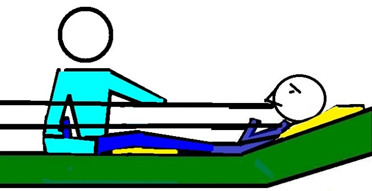
Picture 3: A situation in which the therapist test what the amount of pressure against the feet sole will give the push-away reaction. In this case no clear loss of mobility in the joint thus when the reaction is there, will this be on call with some hard pillow – picture 4

Picture 4: Now the space between the feet and the back of the bed is full with hard pillow and the dorsal flexion is maximal, this all to stimulated the brain to push away. Often people find this not fine and that means that the stimulus has enter the brain. Important detail the head rest stand up and that is important by all neurological diseases because flat lying can increase the extension tone starting in the neck and that makes a reaction more difficult (Tonic Labyrinth Reaction [17]).
Thus, a stable bed and after a reaction on it, the push-away pillows. Thus, this starts about an hour before the caregivers start with the ADL and transfers. Of course, asked every individual for an own approach and also the timing but a good multidisciplinary team will find this fast. When the mobility in the joints is restricted through so-called “contractures” [20] than is the stability much more difficult and is beside a stable bed, a head rests up also an orthosis necessary to create that stability. Thus, first increase stability and then must we determinate how we can change this orthosis in a push -away orthosis.
That means 3 elements and every time test the tone after that intervention;
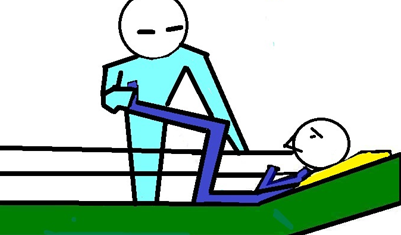
Picture 5: Test to determinate in which position this person push the hand away, that stand against the foot soles.
But again, this push-away orthosis will be useful in a restricted amount of time and thus on 2 or 3 occasion through the day with an effect of an hour mostly! However, when this effect can increase through a harder matrass, head rest position and an orthosis that stabilized the legs and can give an elongation of this effect. This orthosis must give stability, that stability must enter the brain and to controlled that is only measurement of the tone the right option and not the picture that we see. Often the comment is that the person lies relaxed but when the tone was measured the opposite was true. The tone was so high that movement wasn’t possible.
There are the criteria for such an orthosis;
And always measure the tone when there is a reaction and measure also after hour. We know that measurements can increase the tone but it is so important to know what the interventions do!
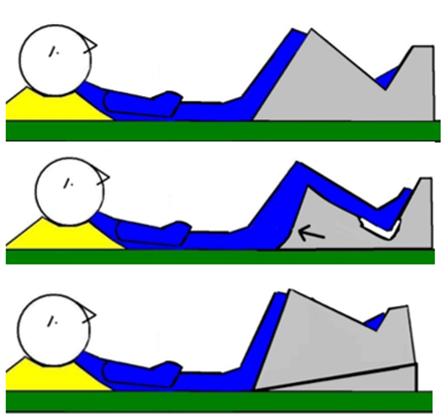
Picture 6, 7 and 8: How the orthosis is built up with a clear support area for the feet and still with a protection “gap” for the heel to prevent pressure scores (picture 7). Picture 7 let us see how an orthosis looks like when the side part is “removed”. Picture 8 give an impression when we place an extra part under the orthosis to create a push away orthosis.
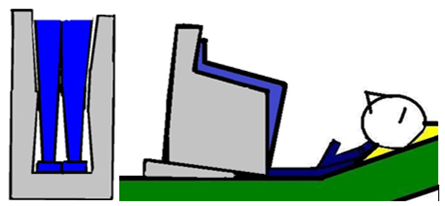
Picture 9 and 10: The first picture let us see how the legs are placed in the orthosis and make clear how this gives information but also stability not only by the feet but also along the side and back of the legs. Picture 10 give an impression when the position of the legs is extreme than must the orthosis be so that placing can be easy and again with an extra piece can change in an push-away orthosis.
The last stage of the disease of Parkinson gives often a tone that is extreme and make people so stiff that movement starting is almost impossible Especially in the morning is this often a great problem for both parties. There is a solution with its restriction qua time and can help the start and other moments through the day. The morning makes transfers and ADL easier but often also the possibilities to eat/swallow and there is often also a cognitive improvement. Through wise chooses through the day can these moments give a better quality of life, but it asked for measurements of the tone and. a multidisciplinary team. This measurement of the tone is so important because than will be clear or this intervention works and when not, it should inspire us to search further. The effect of the treatment of the Pisa -syndrome [7] through higher pressure with the reaction of pushing away, has never be found as the tone measurements not be the base for this investigation and treatment.
Clearly Auctoresonline and particularly Psychology and Mental Health Care Journal is dedicated to improving health care services for individuals and populations. The editorial boards' ability to efficiently recognize and share the global importance of health literacy with a variety of stakeholders. Auctoresonline publishing platform can be used to facilitate of optimal client-based services and should be added to health care professionals' repertoire of evidence-based health care resources.

Journal of Clinical Cardiology and Cardiovascular Intervention The submission and review process was adequate. However I think that the publication total value should have been enlightened in early fases. Thank you for all.

Journal of Women Health Care and Issues By the present mail, I want to say thank to you and tour colleagues for facilitating my published article. Specially thank you for the peer review process, support from the editorial office. I appreciate positively the quality of your journal.
Journal of Clinical Research and Reports I would be very delighted to submit my testimonial regarding the reviewer board and the editorial office. The reviewer board were accurate and helpful regarding any modifications for my manuscript. And the editorial office were very helpful and supportive in contacting and monitoring with any update and offering help. It was my pleasure to contribute with your promising Journal and I am looking forward for more collaboration.

We would like to thank the Journal of Thoracic Disease and Cardiothoracic Surgery because of the services they provided us for our articles. The peer-review process was done in a very excellent time manner, and the opinions of the reviewers helped us to improve our manuscript further. The editorial office had an outstanding correspondence with us and guided us in many ways. During a hard time of the pandemic that is affecting every one of us tremendously, the editorial office helped us make everything easier for publishing scientific work. Hope for a more scientific relationship with your Journal.

The peer-review process which consisted high quality queries on the paper. I did answer six reviewers’ questions and comments before the paper was accepted. The support from the editorial office is excellent.

Journal of Neuroscience and Neurological Surgery. I had the experience of publishing a research article recently. The whole process was simple from submission to publication. The reviewers made specific and valuable recommendations and corrections that improved the quality of my publication. I strongly recommend this Journal.

Dr. Katarzyna Byczkowska My testimonial covering: "The peer review process is quick and effective. The support from the editorial office is very professional and friendly. Quality of the Clinical Cardiology and Cardiovascular Interventions is scientific and publishes ground-breaking research on cardiology that is useful for other professionals in the field.

Thank you most sincerely, with regard to the support you have given in relation to the reviewing process and the processing of my article entitled "Large Cell Neuroendocrine Carcinoma of The Prostate Gland: A Review and Update" for publication in your esteemed Journal, Journal of Cancer Research and Cellular Therapeutics". The editorial team has been very supportive.

Testimony of Journal of Clinical Otorhinolaryngology: work with your Reviews has been a educational and constructive experience. The editorial office were very helpful and supportive. It was a pleasure to contribute to your Journal.

Dr. Bernard Terkimbi Utoo, I am happy to publish my scientific work in Journal of Women Health Care and Issues (JWHCI). The manuscript submission was seamless and peer review process was top notch. I was amazed that 4 reviewers worked on the manuscript which made it a highly technical, standard and excellent quality paper. I appreciate the format and consideration for the APC as well as the speed of publication. It is my pleasure to continue with this scientific relationship with the esteem JWHCI.

This is an acknowledgment for peer reviewers, editorial board of Journal of Clinical Research and Reports. They show a lot of consideration for us as publishers for our research article “Evaluation of the different factors associated with side effects of COVID-19 vaccination on medical students, Mutah university, Al-Karak, Jordan”, in a very professional and easy way. This journal is one of outstanding medical journal.
Dear Hao Jiang, to Journal of Nutrition and Food Processing We greatly appreciate the efficient, professional and rapid processing of our paper by your team. If there is anything else we should do, please do not hesitate to let us know. On behalf of my co-authors, we would like to express our great appreciation to editor and reviewers.

As an author who has recently published in the journal "Brain and Neurological Disorders". I am delighted to provide a testimonial on the peer review process, editorial office support, and the overall quality of the journal. The peer review process at Brain and Neurological Disorders is rigorous and meticulous, ensuring that only high-quality, evidence-based research is published. The reviewers are experts in their fields, and their comments and suggestions were constructive and helped improve the quality of my manuscript. The review process was timely and efficient, with clear communication from the editorial office at each stage. The support from the editorial office was exceptional throughout the entire process. The editorial staff was responsive, professional, and always willing to help. They provided valuable guidance on formatting, structure, and ethical considerations, making the submission process seamless. Moreover, they kept me informed about the status of my manuscript and provided timely updates, which made the process less stressful. The journal Brain and Neurological Disorders is of the highest quality, with a strong focus on publishing cutting-edge research in the field of neurology. The articles published in this journal are well-researched, rigorously peer-reviewed, and written by experts in the field. The journal maintains high standards, ensuring that readers are provided with the most up-to-date and reliable information on brain and neurological disorders. In conclusion, I had a wonderful experience publishing in Brain and Neurological Disorders. The peer review process was thorough, the editorial office provided exceptional support, and the journal's quality is second to none. I would highly recommend this journal to any researcher working in the field of neurology and brain disorders.

Dear Agrippa Hilda, Journal of Neuroscience and Neurological Surgery, Editorial Coordinator, I trust this message finds you well. I want to extend my appreciation for considering my article for publication in your esteemed journal. I am pleased to provide a testimonial regarding the peer review process and the support received from your editorial office. The peer review process for my paper was carried out in a highly professional and thorough manner. The feedback and comments provided by the authors were constructive and very useful in improving the quality of the manuscript. This rigorous assessment process undoubtedly contributes to the high standards maintained by your journal.

International Journal of Clinical Case Reports and Reviews. I strongly recommend to consider submitting your work to this high-quality journal. The support and availability of the Editorial staff is outstanding and the review process was both efficient and rigorous.

Thank you very much for publishing my Research Article titled “Comparing Treatment Outcome Of Allergic Rhinitis Patients After Using Fluticasone Nasal Spray And Nasal Douching" in the Journal of Clinical Otorhinolaryngology. As Medical Professionals we are immensely benefited from study of various informative Articles and Papers published in this high quality Journal. I look forward to enriching my knowledge by regular study of the Journal and contribute my future work in the field of ENT through the Journal for use by the medical fraternity. The support from the Editorial office was excellent and very prompt. I also welcome the comments received from the readers of my Research Article.

Dear Erica Kelsey, Editorial Coordinator of Cancer Research and Cellular Therapeutics Our team is very satisfied with the processing of our paper by your journal. That was fast, efficient, rigorous, but without unnecessary complications. We appreciated the very short time between the submission of the paper and its publication on line on your site.

I am very glad to say that the peer review process is very successful and fast and support from the Editorial Office. Therefore, I would like to continue our scientific relationship for a long time. And I especially thank you for your kindly attention towards my article. Have a good day!

"We recently published an article entitled “Influence of beta-Cyclodextrins upon the Degradation of Carbofuran Derivatives under Alkaline Conditions" in the Journal of “Pesticides and Biofertilizers” to show that the cyclodextrins protect the carbamates increasing their half-life time in the presence of basic conditions This will be very helpful to understand carbofuran behaviour in the analytical, agro-environmental and food areas. We greatly appreciated the interaction with the editor and the editorial team; we were particularly well accompanied during the course of the revision process, since all various steps towards publication were short and without delay".

I would like to express my gratitude towards you process of article review and submission. I found this to be very fair and expedient. Your follow up has been excellent. I have many publications in national and international journal and your process has been one of the best so far. Keep up the great work.

We are grateful for this opportunity to provide a glowing recommendation to the Journal of Psychiatry and Psychotherapy. We found that the editorial team were very supportive, helpful, kept us abreast of timelines and over all very professional in nature. The peer review process was rigorous, efficient and constructive that really enhanced our article submission. The experience with this journal remains one of our best ever and we look forward to providing future submissions in the near future.

I am very pleased to serve as EBM of the journal, I hope many years of my experience in stem cells can help the journal from one way or another. As we know, stem cells hold great potential for regenerative medicine, which are mostly used to promote the repair response of diseased, dysfunctional or injured tissue using stem cells or their derivatives. I think Stem Cell Research and Therapeutics International is a great platform to publish and share the understanding towards the biology and translational or clinical application of stem cells.

I would like to give my testimony in the support I have got by the peer review process and to support the editorial office where they were of asset to support young author like me to be encouraged to publish their work in your respected journal and globalize and share knowledge across the globe. I really give my great gratitude to your journal and the peer review including the editorial office.

I am delighted to publish our manuscript entitled "A Perspective on Cocaine Induced Stroke - Its Mechanisms and Management" in the Journal of Neuroscience and Neurological Surgery. The peer review process, support from the editorial office, and quality of the journal are excellent. The manuscripts published are of high quality and of excellent scientific value. I recommend this journal very much to colleagues.

Dr.Tania Muñoz, My experience as researcher and author of a review article in The Journal Clinical Cardiology and Interventions has been very enriching and stimulating. The editorial team is excellent, performs its work with absolute responsibility and delivery. They are proactive, dynamic and receptive to all proposals. Supporting at all times the vast universe of authors who choose them as an option for publication. The team of review specialists, members of the editorial board, are brilliant professionals, with remarkable performance in medical research and scientific methodology. Together they form a frontline team that consolidates the JCCI as a magnificent option for the publication and review of high-level medical articles and broad collective interest. I am honored to be able to share my review article and open to receive all your comments.

“The peer review process of JPMHC is quick and effective. Authors are benefited by good and professional reviewers with huge experience in the field of psychology and mental health. The support from the editorial office is very professional. People to contact to are friendly and happy to help and assist any query authors might have. Quality of the Journal is scientific and publishes ground-breaking research on mental health that is useful for other professionals in the field”.

Dear editorial department: On behalf of our team, I hereby certify the reliability and superiority of the International Journal of Clinical Case Reports and Reviews in the peer review process, editorial support, and journal quality. Firstly, the peer review process of the International Journal of Clinical Case Reports and Reviews is rigorous, fair, transparent, fast, and of high quality. The editorial department invites experts from relevant fields as anonymous reviewers to review all submitted manuscripts. These experts have rich academic backgrounds and experience, and can accurately evaluate the academic quality, originality, and suitability of manuscripts. The editorial department is committed to ensuring the rigor of the peer review process, while also making every effort to ensure a fast review cycle to meet the needs of authors and the academic community. Secondly, the editorial team of the International Journal of Clinical Case Reports and Reviews is composed of a group of senior scholars and professionals with rich experience and professional knowledge in related fields. The editorial department is committed to assisting authors in improving their manuscripts, ensuring their academic accuracy, clarity, and completeness. Editors actively collaborate with authors, providing useful suggestions and feedback to promote the improvement and development of the manuscript. We believe that the support of the editorial department is one of the key factors in ensuring the quality of the journal. Finally, the International Journal of Clinical Case Reports and Reviews is renowned for its high- quality articles and strict academic standards. The editorial department is committed to publishing innovative and academically valuable research results to promote the development and progress of related fields. The International Journal of Clinical Case Reports and Reviews is reasonably priced and ensures excellent service and quality ratio, allowing authors to obtain high-level academic publishing opportunities in an affordable manner. I hereby solemnly declare that the International Journal of Clinical Case Reports and Reviews has a high level of credibility and superiority in terms of peer review process, editorial support, reasonable fees, and journal quality. Sincerely, Rui Tao.

Clinical Cardiology and Cardiovascular Interventions I testity the covering of the peer review process, support from the editorial office, and quality of the journal.

Clinical Cardiology and Cardiovascular Interventions, we deeply appreciate the interest shown in our work and its publication. It has been a true pleasure to collaborate with you. The peer review process, as well as the support provided by the editorial office, have been exceptional, and the quality of the journal is very high, which was a determining factor in our decision to publish with you.
The peer reviewers process is quick and effective, the supports from editorial office is excellent, the quality of journal is high. I would like to collabroate with Internatioanl journal of Clinical Case Reports and Reviews journal clinically in the future time.

Clinical Cardiology and Cardiovascular Interventions, I would like to express my sincerest gratitude for the trust placed in our team for the publication in your journal. It has been a true pleasure to collaborate with you on this project. I am pleased to inform you that both the peer review process and the attention from the editorial coordination have been excellent. Your team has worked with dedication and professionalism to ensure that your publication meets the highest standards of quality. We are confident that this collaboration will result in mutual success, and we are eager to see the fruits of this shared effort.

Dear Dr. Jessica Magne, Editorial Coordinator 0f Clinical Cardiology and Cardiovascular Interventions, I hope this message finds you well. I want to express my utmost gratitude for your excellent work and for the dedication and speed in the publication process of my article titled "Navigating Innovation: Qualitative Insights on Using Technology for Health Education in Acute Coronary Syndrome Patients." I am very satisfied with the peer review process, the support from the editorial office, and the quality of the journal. I hope we can maintain our scientific relationship in the long term.
Dear Monica Gissare, - Editorial Coordinator of Nutrition and Food Processing. ¨My testimony with you is truly professional, with a positive response regarding the follow-up of the article and its review, you took into account my qualities and the importance of the topic¨.

Dear Dr. Jessica Magne, Editorial Coordinator 0f Clinical Cardiology and Cardiovascular Interventions, The review process for the article “The Handling of Anti-aggregants and Anticoagulants in the Oncologic Heart Patient Submitted to Surgery” was extremely rigorous and detailed. From the initial submission to the final acceptance, the editorial team at the “Journal of Clinical Cardiology and Cardiovascular Interventions” demonstrated a high level of professionalism and dedication. The reviewers provided constructive and detailed feedback, which was essential for improving the quality of our work. Communication was always clear and efficient, ensuring that all our questions were promptly addressed. The quality of the “Journal of Clinical Cardiology and Cardiovascular Interventions” is undeniable. It is a peer-reviewed, open-access publication dedicated exclusively to disseminating high-quality research in the field of clinical cardiology and cardiovascular interventions. The journal's impact factor is currently under evaluation, and it is indexed in reputable databases, which further reinforces its credibility and relevance in the scientific field. I highly recommend this journal to researchers looking for a reputable platform to publish their studies.

Dear Editorial Coordinator of the Journal of Nutrition and Food Processing! "I would like to thank the Journal of Nutrition and Food Processing for including and publishing my article. The peer review process was very quick, movement and precise. The Editorial Board has done an extremely conscientious job with much help, valuable comments and advices. I find the journal very valuable from a professional point of view, thank you very much for allowing me to be part of it and I would like to participate in the future!”

Dealing with The Journal of Neurology and Neurological Surgery was very smooth and comprehensive. The office staff took time to address my needs and the response from editors and the office was prompt and fair. I certainly hope to publish with this journal again.Their professionalism is apparent and more than satisfactory. Susan Weiner

My Testimonial Covering as fellowing: Lin-Show Chin. The peer reviewers process is quick and effective, the supports from editorial office is excellent, the quality of journal is high. I would like to collabroate with Internatioanl journal of Clinical Case Reports and Reviews.

My experience publishing in Psychology and Mental Health Care was exceptional. The peer review process was rigorous and constructive, with reviewers providing valuable insights that helped enhance the quality of our work. The editorial team was highly supportive and responsive, making the submission process smooth and efficient. The journal's commitment to high standards and academic rigor makes it a respected platform for quality research. I am grateful for the opportunity to publish in such a reputable journal.
My experience publishing in International Journal of Clinical Case Reports and Reviews was exceptional. I Come forth to Provide a Testimonial Covering the Peer Review Process and the editorial office for the Professional and Impartial Evaluation of the Manuscript.

I would like to offer my testimony in the support. I have received through the peer review process and support the editorial office where they are to support young authors like me, encourage them to publish their work in your esteemed journals, and globalize and share knowledge globally. I really appreciate your journal, peer review, and editorial office.
Dear Agrippa Hilda- Editorial Coordinator of Journal of Neuroscience and Neurological Surgery, "The peer review process was very quick and of high quality, which can also be seen in the articles in the journal. The collaboration with the editorial office was very good."

I would like to express my sincere gratitude for the support and efficiency provided by the editorial office throughout the publication process of my article, “Delayed Vulvar Metastases from Rectal Carcinoma: A Case Report.” I greatly appreciate the assistance and guidance I received from your team, which made the entire process smooth and efficient. The peer review process was thorough and constructive, contributing to the overall quality of the final article. I am very grateful for the high level of professionalism and commitment shown by the editorial staff, and I look forward to maintaining a long-term collaboration with the International Journal of Clinical Case Reports and Reviews.
To Dear Erin Aust, I would like to express my heartfelt appreciation for the opportunity to have my work published in this esteemed journal. The entire publication process was smooth and well-organized, and I am extremely satisfied with the final result. The Editorial Team demonstrated the utmost professionalism, providing prompt and insightful feedback throughout the review process. Their clear communication and constructive suggestions were invaluable in enhancing my manuscript, and their meticulous attention to detail and dedication to quality are truly commendable. Additionally, the support from the Editorial Office was exceptional. From the initial submission to the final publication, I was guided through every step of the process with great care and professionalism. The team's responsiveness and assistance made the entire experience both easy and stress-free. I am also deeply impressed by the quality and reputation of the journal. It is an honor to have my research featured in such a respected publication, and I am confident that it will make a meaningful contribution to the field.

"I am grateful for the opportunity of contributing to [International Journal of Clinical Case Reports and Reviews] and for the rigorous review process that enhances the quality of research published in your esteemed journal. I sincerely appreciate the time and effort of your team who have dedicatedly helped me in improvising changes and modifying my manuscript. The insightful comments and constructive feedback provided have been invaluable in refining and strengthening my work".

I thank the ‘Journal of Clinical Research and Reports’ for accepting this article for publication. This is a rigorously peer reviewed journal which is on all major global scientific data bases. I note the review process was prompt, thorough and professionally critical. It gave us an insight into a number of important scientific/statistical issues. The review prompted us to review the relevant literature again and look at the limitations of the study. The peer reviewers were open, clear in the instructions and the editorial team was very prompt in their communication. This journal certainly publishes quality research articles. I would recommend the journal for any future publications.

Dear Jessica Magne, with gratitude for the joint work. Fast process of receiving and processing the submitted scientific materials in “Clinical Cardiology and Cardiovascular Interventions”. High level of competence of the editors with clear and correct recommendations and ideas for enriching the article.

We found the peer review process quick and positive in its input. The support from the editorial officer has been very agile, always with the intention of improving the article and taking into account our subsequent corrections.

My article, titled 'No Way Out of the Smartphone Epidemic Without Considering the Insights of Brain Research,' has been republished in the International Journal of Clinical Case Reports and Reviews. The review process was seamless and professional, with the editors being both friendly and supportive. I am deeply grateful for their efforts.
To Dear Erin Aust – Editorial Coordinator of Journal of General Medicine and Clinical Practice! I declare that I am absolutely satisfied with your work carried out with great competence in following the manuscript during the various stages from its receipt, during the revision process to the final acceptance for publication. Thank Prof. Elvira Farina

Dear Jessica, and the super professional team of the ‘Clinical Cardiology and Cardiovascular Interventions’ I am sincerely grateful to the coordinated work of the journal team for the no problem with the submission of my manuscript: “Cardiometabolic Disorders in A Pregnant Woman with Severe Preeclampsia on the Background of Morbid Obesity (Case Report).” The review process by 5 experts was fast, and the comments were professional, which made it more specific and academic, and the process of publication and presentation of the article was excellent. I recommend that my colleagues publish articles in this journal, and I am interested in further scientific cooperation. Sincerely and best wishes, Dr. Oleg Golyanovskiy.

Dear Ashley Rosa, Editorial Coordinator of the journal - Psychology and Mental Health Care. " The process of obtaining publication of my article in the Psychology and Mental Health Journal was positive in all areas. The peer review process resulted in a number of valuable comments, the editorial process was collaborative and timely, and the quality of this journal has been quickly noticed, resulting in alternative journals contacting me to publish with them." Warm regards, Susan Anne Smith, PhD. Australian Breastfeeding Association.

Dear Jessica Magne, Editorial Coordinator, Clinical Cardiology and Cardiovascular Interventions, Auctores Publishing LLC. I appreciate the journal (JCCI) editorial office support, the entire team leads were always ready to help, not only on technical front but also on thorough process. Also, I should thank dear reviewers’ attention to detail and creative approach to teach me and bring new insights by their comments. Surely, more discussions and introduction of other hemodynamic devices would provide better prevention and management of shock states. Your efforts and dedication in presenting educational materials in this journal are commendable. Best wishes from, Farahnaz Fallahian.
Dear Maria Emerson, Editorial Coordinator, International Journal of Clinical Case Reports and Reviews, Auctores Publishing LLC. I am delighted to have published our manuscript, "Acute Colonic Pseudo-Obstruction (ACPO): A rare but serious complication following caesarean section." I want to thank the editorial team, especially Maria Emerson, for their prompt review of the manuscript, quick responses to queries, and overall support. Yours sincerely Dr. Victor Olagundoye.

Dear Ashley Rosa, Editorial Coordinator, International Journal of Clinical Case Reports and Reviews. Many thanks for publishing this manuscript after I lost confidence the editors were most helpful, more than other journals Best wishes from, Susan Anne Smith, PhD. Australian Breastfeeding Association.

Dear Agrippa Hilda, Editorial Coordinator, Journal of Neuroscience and Neurological Surgery. The entire process including article submission, review, revision, and publication was extremely easy. The journal editor was prompt and helpful, and the reviewers contributed to the quality of the paper. Thank you so much! Eric Nussbaum, MD
Dr Hala Al Shaikh This is to acknowledge that the peer review process for the article ’ A Novel Gnrh1 Gene Mutation in Four Omani Male Siblings, Presentation and Management ’ sent to the International Journal of Clinical Case Reports and Reviews was quick and smooth. The editorial office was prompt with easy communication.

Dear Erin Aust, Editorial Coordinator, Journal of General Medicine and Clinical Practice. We are pleased to share our experience with the “Journal of General Medicine and Clinical Practice”, following the successful publication of our article. The peer review process was thorough and constructive, helping to improve the clarity and quality of the manuscript. We are especially thankful to Ms. Erin Aust, the Editorial Coordinator, for her prompt communication and continuous support throughout the process. Her professionalism ensured a smooth and efficient publication experience. The journal upholds high editorial standards, and we highly recommend it to fellow researchers seeking a credible platform for their work. Best wishes By, Dr. Rakhi Mishra.

Dear Jessica Magne, Editorial Coordinator, Clinical Cardiology and Cardiovascular Interventions, Auctores Publishing LLC. The peer review process of the journal of Clinical Cardiology and Cardiovascular Interventions was excellent and fast, as was the support of the editorial office and the quality of the journal. Kind regards Walter F. Riesen Prof. Dr. Dr. h.c. Walter F. Riesen.

Dear Ashley Rosa, Editorial Coordinator, International Journal of Clinical Case Reports and Reviews, Auctores Publishing LLC. Thank you for publishing our article, Exploring Clozapine's Efficacy in Managing Aggression: A Multiple Single-Case Study in Forensic Psychiatry in the international journal of clinical case reports and reviews. We found the peer review process very professional and efficient. The comments were constructive, and the whole process was efficient. On behalf of the co-authors, I would like to thank you for publishing this article. With regards, Dr. Jelle R. Lettinga.

Dear Clarissa Eric, Editorial Coordinator, Journal of Clinical Case Reports and Studies, I would like to express my deep admiration for the exceptional professionalism demonstrated by your journal. I am thoroughly impressed by the speed of the editorial process, the substantive and insightful reviews, and the meticulous preparation of the manuscript for publication. Additionally, I greatly appreciate the courteous and immediate responses from your editorial office to all my inquiries. Best Regards, Dariusz Ziora

Dear Chrystine Mejia, Editorial Coordinator, Journal of Neurodegeneration and Neurorehabilitation, Auctores Publishing LLC, We would like to thank the editorial team for the smooth and high-quality communication leading up to the publication of our article in the Journal of Neurodegeneration and Neurorehabilitation. The reviewers have extensive knowledge in the field, and their relevant questions helped to add value to our publication. Kind regards, Dr. Ravi Shrivastava.

Dear Clarissa Eric, Editorial Coordinator, Journal of Clinical Case Reports and Studies, Auctores Publishing LLC, USA Office: +1-(302)-520-2644. I would like to express my sincere appreciation for the efficient and professional handling of my case report by the ‘Journal of Clinical Case Reports and Studies’. The peer review process was not only fast but also highly constructive—the reviewers’ comments were clear, relevant, and greatly helped me improve the quality and clarity of my manuscript. I also received excellent support from the editorial office throughout the process. Communication was smooth and timely, and I felt well guided at every stage, from submission to publication. The overall quality and rigor of the journal are truly commendable. I am pleased to have published my work with Journal of Clinical Case Reports and Studies, and I look forward to future opportunities for collaboration. Sincerely, Aline Tollet, UCLouvain.

Dear Ms. Mayra Duenas, Editorial Coordinator, International Journal of Clinical Case Reports and Reviews. “The International Journal of Clinical Case Reports and Reviews represented the “ideal house” to share with the research community a first experience with the use of the Simeox device for speech rehabilitation. High scientific reputation and attractive website communication were first determinants for the selection of this Journal, and the following submission process exceeded expectations: fast but highly professional peer review, great support by the editorial office, elegant graphic layout. Exactly what a dynamic research team - also composed by allied professionals - needs!" From, Chiara Beccaluva, PT - Italy.

Dear Maria Emerson, Editorial Coordinator, we have deeply appreciated the professionalism demonstrated by the International Journal of Clinical Case Reports and Reviews. The reviewers have extensive knowledge of our field and have been very efficient and fast in supporting the process. I am really looking forward to further collaboration. Thanks. Best regards, Dr. Claudio Ligresti